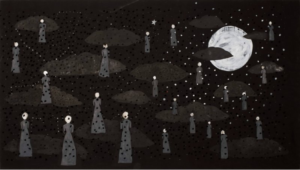
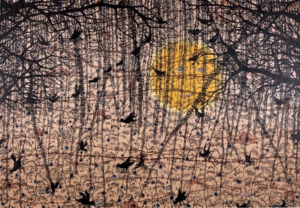
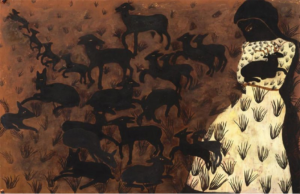
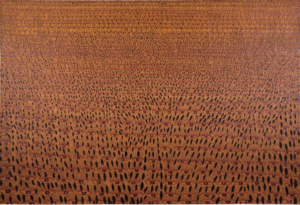
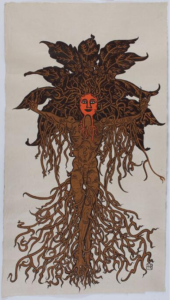
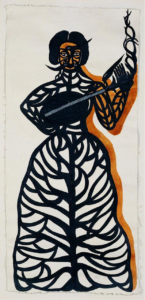
List of paintings shown in gallery: 1. Beauties in the Moonlight; 2. Heaven III; 3. The Night;. 4. Eyes; 5. Tree Woman; 6. Self-portrait.
The aim of this brief note is not to supply the reader with bibliographical detail on the remarkable Turkish artist Selma Gürbüz who died last week at the relatively young age of 61, but rather to summon up the spirit of her work by translating and paraphrasing a paragraph from an essay the writer Fert Edgü wrote on her a few years ago. Any quick internet search will supply the reader with the details of her life and death and might also suggest that she forged a remarkable and rich body of work. However, the reader will struggle to find anything in English on the nature of that work. The sad fact is that there is very little written in the western languages on the modern artists of Turkey. And so we have recourse to the words of Ferit Edgü, who speaks of her as being:
“An artist who bears no resemblance to any of her peers. In order to find anyone or anything similar to her we should turn, not to the art of our day, but to that of the very distant past. Her world is not that of landscapes, mountain tops, seashores, apples, pears or nudes. Instead it emerges from the grains of Turkish coffee (and therefore from fortune-telling), from the dreamlike creatures of fairy tales, from ghosts, djinns, fairies, from the Mundus Elementaris of the alchemists, from the 1,003 Nights, and from the blacks, whites and greys cast by various spells. She draws sustenance from the Karagöz puppets, from shamans and old talismans, from the mysterious figures of Siyah Qalem, from old Ottoman books on astrology and divination. In her art these inspirations are used either as a starting or a finishing point”.
He goes onto to say that Gürbüz, by weaving all of the aforementioned elements together, creates both a world and a mythology of her own, and adds that “these figures she carries out of a medieval darkness dance shamanistic dances on the hide of modernity. So much so that the viewer feels that they are not of the past but are, in fact, signposts to the future”.
Her early death has robbed us, her viewers, of fresh signposts to a future that currently feels more uncertain than ever.
Work Cited:
Semla Gürbüz’ün Büyüler, Tılsımlar Ülkesinde Bir Gezinti. Sel Yayınları, İstanbul. 2011.
Selma Gürbüz 1960-2021


























































